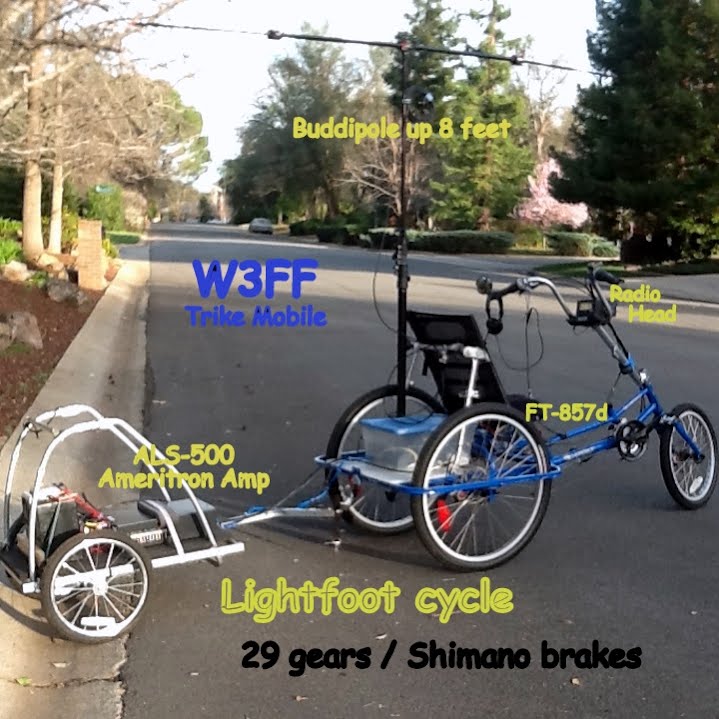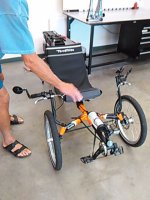Alan B
100 GW
A friend of mine built a very special Trike setup with the capability to operate High Frequency Ham Radio from it when stationary. It doesn't have electric assist, though I've suggested it and Budd is considering it when he has trouble pedaling. It is fairly flat where he is, and he's not going far so it hasn't been a problem for him yet, at age 75.

So here is Budd's Trike with Trailer. He doesn't bother with the trailer (with amplifier) when radio propagation conditions are good, and he runs 100 watts on the upper HF bands with a mobile radio via a remote head with just the trike. When propagation is poor he can drag the trailer along and increase the RF power to 500 watts using the amplifier and battery on the trailer.
===
I've been thinking for awhile about doing my own Radio Active Trike. I would rather use a Tadpole that has plenty of room under the seat for a tray to carry batteries and radio equipment (and room behind the seat), and put the antenna on a mount above the rear wheel. Riding near the salt water or up to a hilltop gives the signal a big boost and a well chosen location can get away from the RF noise so it can help both transmission and reception and increase range. A trike is nice for the weight carrying capacity and the comfort of sitting on a seat. A sunshade would be nice also.
There is likely to be interference from the ebike motor, so best HF radio operating will be when the ebike motor is off, and the larger antennas will be put away when in motion, so stopping and setting up the antenna may be necessary for best radio effect. For VHF/UHF FM operation the antenna is small and the controller noise should not be a factor, so operating in motion should be possible. APRS (amateur radio location service) is also VHF so could be used when you want to share your location with others which is often useful in event support operations.
I've looked at a few trikes, and one that looks like it has a lot of potential for this project is the TerraTrike Rambler. Three hundred pound load capacity, lots of room under the straight boom and seat as well as behind the seat, room for a rear rack, very adjustable, not too expensive, easy to get into and out of, etc. I've never ridden one, I need to do a test drive before any decisions.

The goal here is not to go particularly fast, but to carry a bunch of equipment and facilitate operating from some good locations that might not be accessible to a vehicle. Not much sense using gas drive around just to make a few radio contacts, anyway. But to add that to a get some fresh air and exercise on a trip would be great. This would also be good for supporting bicycle rides or other public events which Amateur Radio groups are often called on to help with.
There are a lot of nice rides around here, it would be great to do early morning rides in good weather and add some interest besides taking photos, one could stop and talk to some stations in Australia or Japan while sitting in comfort on the trike. Seems like a good retirement hobby - combine Ham Radio and Electric Biking.
So I'd like to get comments and suggestions on the trike and motor selection that would be good for this project, and see what we can figure out before the $ start flowing.
Thanks in advance for your comments and feedback.

So here is Budd's Trike with Trailer. He doesn't bother with the trailer (with amplifier) when radio propagation conditions are good, and he runs 100 watts on the upper HF bands with a mobile radio via a remote head with just the trike. When propagation is poor he can drag the trailer along and increase the RF power to 500 watts using the amplifier and battery on the trailer.
===
I've been thinking for awhile about doing my own Radio Active Trike. I would rather use a Tadpole that has plenty of room under the seat for a tray to carry batteries and radio equipment (and room behind the seat), and put the antenna on a mount above the rear wheel. Riding near the salt water or up to a hilltop gives the signal a big boost and a well chosen location can get away from the RF noise so it can help both transmission and reception and increase range. A trike is nice for the weight carrying capacity and the comfort of sitting on a seat. A sunshade would be nice also.
There is likely to be interference from the ebike motor, so best HF radio operating will be when the ebike motor is off, and the larger antennas will be put away when in motion, so stopping and setting up the antenna may be necessary for best radio effect. For VHF/UHF FM operation the antenna is small and the controller noise should not be a factor, so operating in motion should be possible. APRS (amateur radio location service) is also VHF so could be used when you want to share your location with others which is often useful in event support operations.
I've looked at a few trikes, and one that looks like it has a lot of potential for this project is the TerraTrike Rambler. Three hundred pound load capacity, lots of room under the straight boom and seat as well as behind the seat, room for a rear rack, very adjustable, not too expensive, easy to get into and out of, etc. I've never ridden one, I need to do a test drive before any decisions.

The goal here is not to go particularly fast, but to carry a bunch of equipment and facilitate operating from some good locations that might not be accessible to a vehicle. Not much sense using gas drive around just to make a few radio contacts, anyway. But to add that to a get some fresh air and exercise on a trip would be great. This would also be good for supporting bicycle rides or other public events which Amateur Radio groups are often called on to help with.
There are a lot of nice rides around here, it would be great to do early morning rides in good weather and add some interest besides taking photos, one could stop and talk to some stations in Australia or Japan while sitting in comfort on the trike. Seems like a good retirement hobby - combine Ham Radio and Electric Biking.
So I'd like to get comments and suggestions on the trike and motor selection that would be good for this project, and see what we can figure out before the $ start flowing.
Thanks in advance for your comments and feedback.




